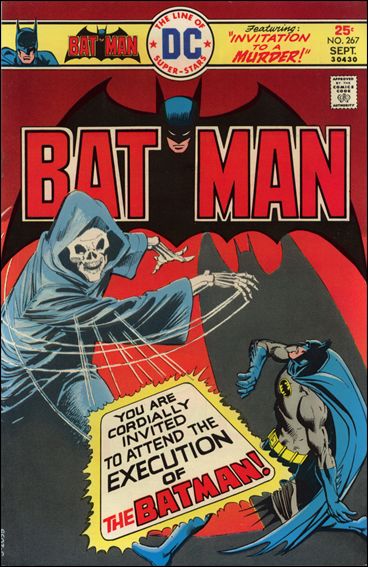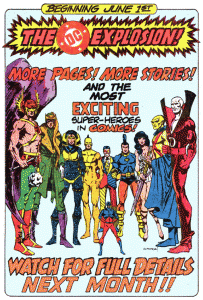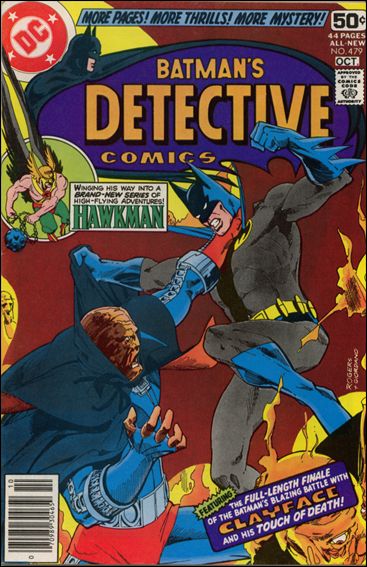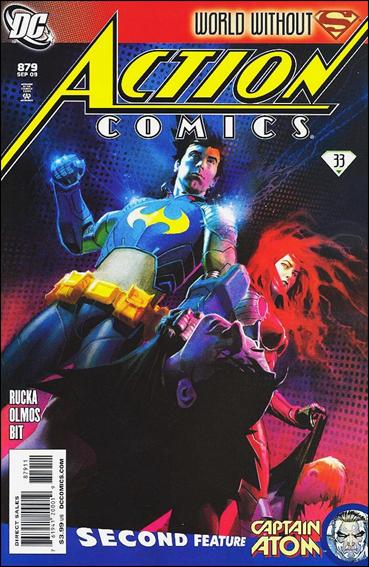Is DC repeating the mistakes of the past?
 Price increases are almost inevitable, especially in the comics world. The earliest comic I remember buying was only 25 cents in the mid-1970s, and some old-timers even remember the original 10-cent price fondly. Pretty soon, prices rose to 30 cents, and then jumped every few months until the early 1980s. After that, they stabilized somewhat, and the price would only get bumped every few years. There are several reasons for the price increases:
Price increases are almost inevitable, especially in the comics world. The earliest comic I remember buying was only 25 cents in the mid-1970s, and some old-timers even remember the original 10-cent price fondly. Pretty soon, prices rose to 30 cents, and then jumped every few months until the early 1980s. After that, they stabilized somewhat, and the price would only get bumped every few years. There are several reasons for the price increases:
- The cost of printing, binding, and distributing comics increases. This was primarily the cause for the late-1970s increases. The economy was mired in infamous “stagflation:” high inflation, high unemployment, and low economic growth. The costs for everything were going up 10-12% per year, and the publishers had to increase prices to cover their costs. After the recovery began in the early 1980s, the prices stabilized as the costs held steady.
- The comic’s format changes. The mid-to-late 1980s saw the introduction of new printing processes that led to improved quality, like the Baxter format and DC’s “New Format.” The format changes led to an improved look for comics (compare old issues published on newsprint to today’s slicker look). This relates back to #1 since these printing processes are inherently more expensive, but a format change can also be used to mask a price increase for other reasons.
- Cost of talent increases. The writers and artists who produce comics have more power today to negotiate better pay for their work. “Celebrity” artists can demand more compensation and control over their work than they could previously. Frank Miller reportedly made $1 million for The Dark Knight Strikes Again! Of course, publishers will pay since a popular creator’s name can sell more books. The sudden departure of Marvel’s stable of artists in the 1990s to found Image illustrated this effect.
- The audience is growing up and dropping off. Like it or not, most comics aren’t for kids any more. Today’s publications are aimed at the collector’s market and long-time older readers who fondly remember stories from their youth. Older readers have more disposable cash and can tolerate a price increase. Also, there’s more competition than ever before from TV, movies, video games, and the internet. Fewer readers mean lower sales, and lower sales means prices must go up to try to recoup production costs.
So today, prices are mainly at $2.99, on the verge of going to $3.99 across the board. While Marvel seems to be targeting certain titles for the $3.99 price, with the assumption they will gradually move everything to that price, DC has adopted a different tactic: adding more pages with backup stories for selected titles at the higher price. Hopefully they’ve looked at the history of such moves.
 In early 1978, the “DC Explosion” was the marketing slogan for a flood of new titles. Between 1975 and 1978, DC had added 15 additional titles to their lineup in an attempt to gain market share. However, costs were rising rapidly; prices had risen from 25 to 35 cents in less than two years, with another hike looming. Rather than just increasing the price to 40 cents, DC decided to expand their format, adding eight pages of story and raising the price to 50 cents. As DC Publisher Jenette Kahn wrote in her “Publishorial” announcing the change: “… It’s a 47% gain in story for a 43% raise in price,” so the argument was that they were providing more value for the extra money. The extra pages were used for longer book-length stories in team books like Justice League of America and for backup features in solo books like Action Comics.
In early 1978, the “DC Explosion” was the marketing slogan for a flood of new titles. Between 1975 and 1978, DC had added 15 additional titles to their lineup in an attempt to gain market share. However, costs were rising rapidly; prices had risen from 25 to 35 cents in less than two years, with another hike looming. Rather than just increasing the price to 40 cents, DC decided to expand their format, adding eight pages of story and raising the price to 50 cents. As DC Publisher Jenette Kahn wrote in her “Publishorial” announcing the change: “… It’s a 47% gain in story for a 43% raise in price,” so the argument was that they were providing more value for the extra money. The extra pages were used for longer book-length stories in team books like Justice League of America and for backup features in solo books like Action Comics.
It was a reasonable move, or so they thought. Unfortunately, their timing couldn’t have been worse!
Only a few weeks after the new format launched, in June 1978, the sales figures from the previous winter came in. A series of snowstorms had paralyzed the Northeast, disrupting distribution and depressing sales even over the ongoing decline due to the bad economy. Executives from DC’s parent company panicked and demanded DC slash production. DC was forced to cancel dozens of titles, cut the size back to 17 pages of story in the survivors, and move the price back to 40 cents.
 Today, the bloodbath is known as the “DC Implosion.” Though most of the canceled titles were forgettable, and arguably overall quality had suffered from the rapid expansion, some key titles met their end. Showcase Comics, which had launched the Silver Age; the revived All Star Comics, the original team book; and long-running horror titles House of Secrets and Witching Hour were among those cut, and even legendary Detective Comics was on the chopping block! Fortunately, the title and numbering were continued by merging it with Batman Family.
Today, the bloodbath is known as the “DC Implosion.” Though most of the canceled titles were forgettable, and arguably overall quality had suffered from the rapid expansion, some key titles met their end. Showcase Comics, which had launched the Silver Age; the revived All Star Comics, the original team book; and long-running horror titles House of Secrets and Witching Hour were among those cut, and even legendary Detective Comics was on the chopping block! Fortunately, the title and numbering were continued by merging it with Batman Family.
So, is DC on the cusp of repeating the implosion of 1978? Possibly.
While inflation is not a problem at present, current economic policy could cause a return to stagflation. Even so, the current recession isn’t helping sales, and raising prices in this environment will force collectors to make hard choices about what titles to purchase. A higher-priced title will look less attractive unless the additional material is worth the extra money.
On the other hand, DC has some factors in their favor that weren’t present in 1978. For one, they aren’t as overextended. Comics publishing today focuses more on limited series with fewer ongoing titles. Looking at 1978, many of the canceled titles only ran for a handful of issues, sometimes only for one or two before cancellation. With a miniseries, there’s a definite end to the story, allowing a higher churn in the number of titles produced and less impact for a bad miniseries. A poorly-received storyline in an ongoing series can throw a stable title into a tailspin, but since a limited series is ending anyway, the reader may choose to drop it or just stick it out. Either way, the series ends. If it’s successful, the publisher can always commission a sequel, or even make it ongoing. If not, they can try something else. For DC’s ongoing titles with the price increase, most of the new backup stories are imports from recently canceled titles, so rather than producing a large number of additional stories, they’re actually consolidating from full-length books to a few additional pages. Additionally, they’ve attempted to match the backups with related titles. While arguably few readers will buy Booster Gold just for the Blue Beetle backup, or Detective Comics for The Question stories, they may look favorably on the additional stories as an extension of the main title. That’s certainly the case for Green Arrow and Black Canary, since the backup story features one of the main characters!
 The triggering event was a precipitous drop in sales exacerbated by a disruption in their distribution chain caused by bad weather. Arguably, that’s less likely today, since the market is based mostly out of direct-market comic shops rather than newsstands. Even if distribution gets delayed, the comics will receive shelf space once they reach their destination, and the customers today tend to use pull lists. While frequent production delays will hurt or even kill a title, an event like the winter of 1977-78 would probably not hurt sales as badly today.
The triggering event was a precipitous drop in sales exacerbated by a disruption in their distribution chain caused by bad weather. Arguably, that’s less likely today, since the market is based mostly out of direct-market comic shops rather than newsstands. Even if distribution gets delayed, the comics will receive shelf space once they reach their destination, and the customers today tend to use pull lists. While frequent production delays will hurt or even kill a title, an event like the winter of 1977-78 would probably not hurt sales as badly today.
The new expanded books have only been in place for a handful of issues, so the impact isn’t definite yet. The latest sales numbers as of this writing are from August, and so there’s only information on the first two installments since the price increase. Overall, there doesn’t seem to be a huge drop due to the price increase; the general trends seem unchanged. Unfortunately, that trend is downward. Generally, a series will decline in readership over time (typically about 1% per month), barring a shakeup in the creative team or a monumental story that draws a lot of interest. It seems the new stories have done nothing to boost sales, though they haven’t hurt them much either. Further complicating matters, the popular Blackest Night event will be crossing over into most of DC’s line over the next few months, possibly boosting sales. It will be several months before the true impact of the price increase will be known.
Still, it seems inevitable that at some point the backup stories will be dropped, but the price hike will stick. So, is DC setting the stage for another implosion? What do you think?
Tom McNeely
tom@comicattack.net


“Older readers have more disposable cash and can tolerate a price increase. ”
I don’t know about that. I think it’s the opposite. Also, that statement is contrary to your article. If older readers are the ones who are still reading, and they’re the ones with the cash to spend, why aren’t they buying more books, therefore keeping the costs from rising?
The whole economy thing gets me deflated to be honest. I really hate to see prices going up while people are losing jobs. I really think a lot of these companies need to re-think some of their corporate strategies along with their high priced Ceo’s as well.
Oh, I made an observation just now….
My Wonder Woman comic had 22 pages of comic content (meaning, without including the ads), and a preview for another comic in the back.
It was $2.99.
My New Avengers comic (Marvel) had 21 pages of comic content, and was $3.99.
That doesn’t add up, but it does show me that DC is cheaper than Marvel.
“As DC Publisher Jenette Kahn wrote in her “Publishorial” announcing the change: “… It’s a 47% gain in story for a 43% raise in price,” so the argument was that they were providing more value for the extra money.”
I question the term ‘value’ here… the backup stories in the DC titles today are pretty weak so far. The ones I read are:
Manhunter (Streets of Gotham): This story actually isn’t too bad, but I could care about the character.
Ravager: (Teen Titans) I love Ravager, but the story is pretty weak.
The Question: (Detective Comics) Montoya is cool and all, but who cares, really?
Black Canary: (Green Arrow/Black Canary) What’s the point of this one? It usually features Black Canary but she’s in the title of the comic as a leading character, so wtf? The last issue of this featured a bedtime story by Speedy that was very, very lame.
“Only a few weeks after the new format launched, in June 1978, the sales figures from the previous winter came in.”
Gotta love the Blizzard of ’77 compliments of my home town, Buffalo, NY!!